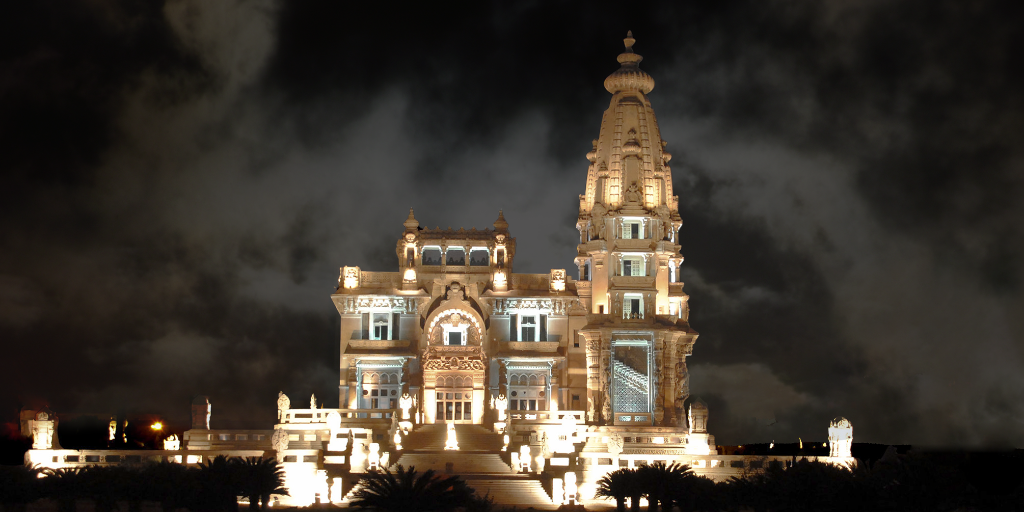In the heart of Heliopolis, one of Cairo’s oldest suburbs, a house of horrors once existed. Long before it became a terrifying legend, it was the extravagant, terracotta-colored, Hindu-inspired home of Baron Edouard Empain, a wealthy Belgian industrialist: better known as the Baron Empain Palace.
Renovations in recent years have refreshed the city’s outlook on the mansion, now a prime tourist destination and wedding venue that heralds Heliopolis’s history. Nevertheless, the petrifying legend behind the palace still remains for those that remember its past – one of alleged mysterious deaths, morbid rumors, and satanic parties.

Image Credit: Sada El Balad
Edouard Empain was not always a Baron. In fact, the noble title of Baron was awarded to him in the later years of his life by Belgium’s King Leopold II in 1907 for Empain’s efforts in industrializing the country. In fact, the industrial tycoon was the child of an underprivileged family.
When Empain visited Egypt for the first time, to rescue a failing project of his company, he fell in love with the country and its people. He bought a stretch of desert land and commissioned his palace to be built on it, becoming the foundation of Heliopolis, an area he would significantly help build during his stay.
The palace was a work of architectural excellence. Heavily influenced by the Baron’s beloved visit to India, he commissioned a French architect to build him a palace similar in design to India’s Odisha temple or Cambodia’s Angkor Wat.
Covered in a harsh terracotta red, adorned with imposing Hindu statues, and placed in the center of Egypt’s desert lands, the house was a domineering reflection of the Baron’s power and status – the Empain’s extraordinary estate. More personally, it was a reflection of the industrial tycoon’s affinity for travel and culture, particularly in the Orient.
Yet the architectural splendor of the Baron’s palace stands in stark contrast to his haunting family life.
Empain’s wife Helene and their daughter Mariam were victims of the household’s horrors. Helene, mentally suffering from the Baron’s playboy antics and affairs, eventually succumbed to a mysterious death in the palace’s food elevator.
Mariam, on the other hand, had always suffered from psychological problems, a matter that the Baron intentionally ignored. Her death, a few years after Helene’s, came from a fall through the palace’s signature spiral staircase.
The two deaths would forever haunt the house and the Baron himself, who would later die of a mysterious disease in 1929. As per the Baron’s will, he was buried in the crypt of Heliopolis’s famed Basilica Catholic Cathedral.
A grim portrait of his wife hangs above his church prayer chair, looking over his tombstone.
Decades later, in 1946, his son and heir, Jean, died and was buried with the Baron – marking the end of the household’s presence in Egypt. The palace experienced a harsh and decrepit period following the Empain family’s exit from the country, graying and cracking with age.
The estate’s destitute nature helped perpetuate the horror folklore inspired by the household’s tragedies. It also inadvertently transformed it into a hotspot for wrongdoers and trespassers.
In 1997, a publicized incident involving the palace and an unauthorized black metal party caused a national outcry, promoting the notion that the palace’s appearance and past incite satanic behavior.
With time, and with top-grade renovations, the Baron Empain Palace’s bone-chilling past and haunting reputation have been buried to make way for a more touristic experience. Once neglected and shunned, it is once more a symbol of pride and history for Heliopolis. A legacy of Empain’s estate and experience in Egypt – a legacy that started with fascination and ended with tragedy and death.







Comments (5)
[…] بيت الرعب؟ الماضي المخيف لقصر البارون في مصر […]
[…] بيت الرعب؟ الماضي المخيف لقصر البارون في مصر تحقيقات وزارة البيئة: تآكل السواحل يصدم الساحل الشمالي لمصر […]